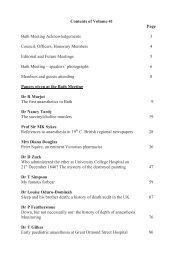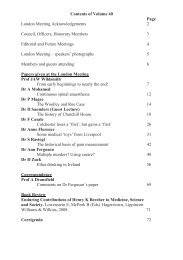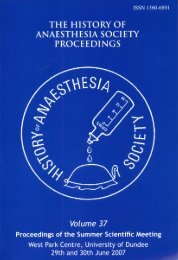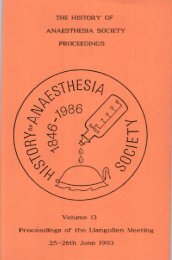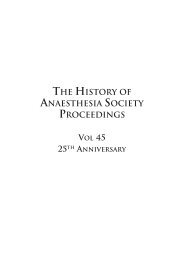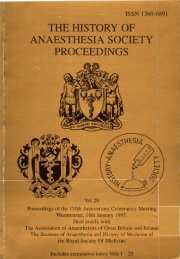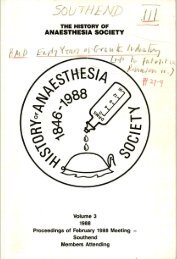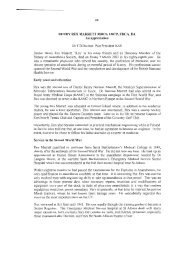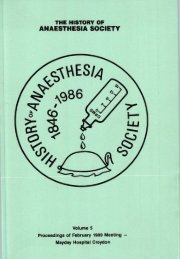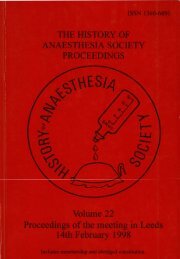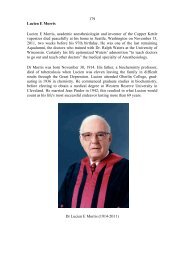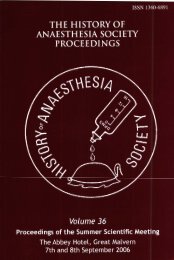Volume 9b - History of Anaesthesia Society
Volume 9b - History of Anaesthesia Society
Volume 9b - History of Anaesthesia Society
You also want an ePaper? Increase the reach of your titles
YUMPU automatically turns print PDFs into web optimized ePapers that Google loves.
plblished m y articles on this approach to hyp~osis, mainly in a<br />
journal 'The Zoist'. In these writings he described many operations<br />
with mesmerism as the only anaesthetic, and stressed the success<br />
achieved. me first such operation, he stated, was performed in the<br />
USA. IX Sydney Dcane <strong>of</strong> New York, removed a neck tmur during a<br />
mesmeric state <strong>of</strong> hypnosis. Pr<strong>of</strong>essor Ackley at the Cleveland Medical<br />
College also used the method. At the Medical College <strong>of</strong> Georgia, LW<br />
Louis mgas successfully rermved a breast during the mesmeric state. In<br />
1842 in England, Dr Ward aqxtated a leg at the thigh while the patient<br />
was mesmerised.<br />
Despite the amrently successful results, the reaction <strong>of</strong> the Royal<br />
Medical and Surgical Colleges was hostile. However, esmeric h p -<br />
anaesthesia was practised by %rd and Elliotson and their results were<br />
pblished in further volumes <strong>of</strong> 'The Zoist' which gave detailed accounts<br />
<strong>of</strong> mesmerism havFng been used in cases <strong>of</strong> childbirth, venisection,<br />
excision <strong>of</strong> tumxlrs, amptations and dental extractions.<br />
Jtaaaa BgdaCle (180&1l359) perfonwd ahout 1,000 mbr and about 300<br />
major operatp in India with patients in the memric state <strong>of</strong> hypoanaesthesia.<br />
The introduction <strong>of</strong> chemical anaesthesia with<br />
chlor<strong>of</strong>orm and ether was a serious drawback for hyploanaesthesia, since<br />
surgeons felt more ccmfortable using the new method.<br />
.Rmw Emid (1795-1860) was a Scottish surgeon who practised in<br />
Mmchester. He observed that a mesmerised patient could not open his<br />
eyes during a session. After performing experiments himself, he came to<br />
the conclusion that hypotic phenomena were entirely subjective. In<br />
1843 he plblished his in a work entitled 'Neurypnology, or The<br />
Rationale <strong>of</strong> Nervous Sleep<br />
Dewlqmmt <strong>of</strong> hypmmaesthesia in the last 50 years<br />
Even though chemical anaesthesia took over in various fom, and with a<br />
wide spectrum <strong>of</strong> drugs, hypnoanaesthesia has remained, and has been the<br />
subject <strong>of</strong> intensive research. The following researchers and clinicians<br />
have paid special attention to the subject:<br />
car1 A<br />
Anesthesiology<br />
Chppo<br />
who wrote the book 'Practice <strong>of</strong> yrplosis in<br />
Jean Idamer, Pr<strong>of</strong>essor and Chainmn <strong>of</strong> the Department <strong>of</strong><br />
Anaesthnsiology at the University <strong>of</strong> Paris who perfomd a y<br />
psychophysiological EEC stuclies during hypnonarcosis. l7<br />
Piner, Pr<strong>of</strong>essor <strong>of</strong> Anaesthesiology at the University <strong>of</strong> Uppsala.<br />
He studied premedication in autohypnosis and had qood results in<br />
prdcat- intra- and postoperative drug consmptior;.<br />
thdolm Ry, Pr<strong>of</strong>essor and Chairman <strong>of</strong> the Department <strong>of</strong><br />
Anaesthesiology. He did extensive research on the question <strong>of</strong> combine3<br />
chemical and hpoanaesthesia. He suggested this combination would save<br />
up to 70% <strong>of</strong> the drug8 used. He contributed to the German literature



